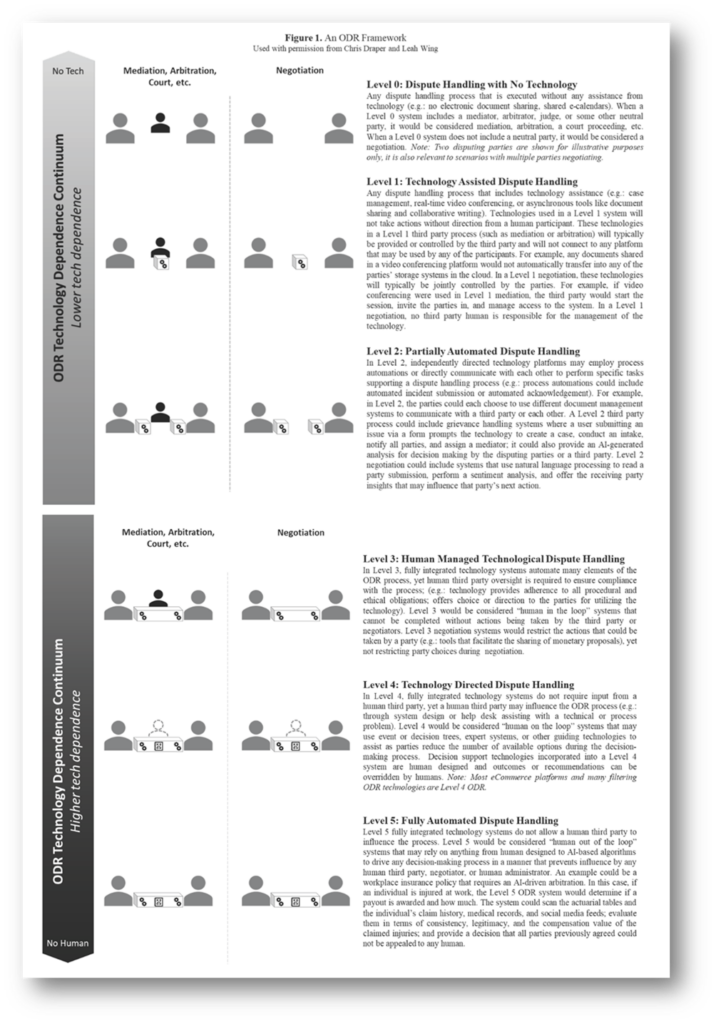Although familiar to everyone in the legal community, the definition of ADR is more complicated than the three simple letters of its acronym. Alternative Dispute Resolution encompasses well-known elements such as Mediation, Arbitration, Settlement Conferences, and the more rarely-discussed process of Neutral Evaluation. The evolution of ADR will include changes to the systems, methods, and, more importantly, the technology used to resolve issues, both before and during litigation. This evolution must focus on safely folding new technologies, such as Artificial Intelligence, into this process.
“The use of technology in dispute handling expanded slowly but steadily until the COVID-19 pandemic forced widespread global usage of videoconferencing.1” This quote from the “Framing the Parameters of Online Dispute Resolution” by the National Center for Technology and Dispute Resolution2 points out one of the obvious ways that the pandemic accelerated technology adoption.
Building on the near-universal adoption of virtual depositions, the new focus will be expanding Online Dispute Resolution (ODR) through new or improved technology. Developing ODR programs will require legal professionals to modify their mindsets and workflows. The adoption of new technology also requires that the legal team manage risks. Some of the dangers are related to issues with protecting the privacy and security of the data. Technology to facilitate ADR is expected to include new tools such as ChatGPT.
The process of ODR is more than using virtual tech to conduct the hearing portion. The Los Angeles Superior Court’s ODR for Unlawful Detainer is an excellent example.3 This program does not facilitate meetings or phone calls. Instead, the Court’s ODR provides a “guided” message negotiation. In addition, the website includes instructional videos and other materials. As a bonus, this progressive program also offers online mediation for free by Mediators training in the system.
The alternatives to litigation (especially jury trials) take several forms. It is important to understand the various processes available to resolve disputes. Below is a table constructed from definitions provided by leading professional groups such as the ABA and the Cornell ADR Center:
--> Scroll to see full table data
--> Scroll to see full table data
Below is a list of some reasoning behind using options other than litigation.
The use of ADR has increased, and there is no reason to believe this trend will change soon. The information on the American Bar Association’s website is useful for the ADR process. The website also discusses other novel ADR systems, including non-business disputes, such as divorce coaching and family group conferences.
Other resources include:
National Arbitration and Mediation (namadr.com)
International Institute for Conflict Prevention & Resolution (cpradr.org)
Association for Conflict Resolution (acrnet.org)
FORUM (adrforum.com)
The National Center for Technology & Dispute Resolution (odr.info)
International Council for Online Dispute Resolution (icodr.org)
The image below of the ODR Framework (within the “Framing the Parameters of Online Dispute Resolution” by the National Center for Technology and Dispute Resolution) is a fantastic example of going from no tech to no human.10
 Framing the Parameters of Online Dispute Resolution, National Center for Technology and Dispute Resolution
Framing the Parameters of Online Dispute Resolution, National Center for Technology and Dispute Resolution
I would be remiss if I did not share this quote regarding ethics considerations by the Director of the National Center for Technology and Dispute Resolution “Without coding fairness and equality into artificial intelligence (AI), it will emerge as an outcome. NO CODE, NO JUSTICE” (Leah Wing)11.
It is essential to consider the ethics involved in using technology as a tool during the ADR process. The mandatory ethical issues to consider range from accessibility to transparency. The categories from the Online Dispute Resolution Standards jointly published by the National Center for Technology and Dispute Resolution and the International Council for Online Dispute Resolution in May 2022 are set forth (in alphabetical order, not in order of importance) below:
- “Accessibility
- Accountability
- Competence
- Confidentiality
- Empowerment
- Equality
- Fairness
- Honesty
- Impartiality
- Informed Participation
- Innovation
- Integration
- Legal Obligation
- Neutrality
- Protection from Harm
- Security
- Transparency”12
The benefits of ODR are apparent, but one crucial future obstacle is that many underserved communities lack the necessary equipment and technology. One of my eMentors, Molly McDonough13 writes a blog regarding access to justice issues at “ajustsocietynow.com.” Molly inspires the legal community to pursue other possible uses of legal tech to close the access to justice gap. New and improved technologies, like the ODR systems, are important in closing the justice access gap.
Additional Resources:
ABA Section of Dispute Resolution
ABA Benefits of Commercial Arbitration
ABA Planned Early Dispute Resolution
ABA Update on federal alternative dispute resolution (ADR) legislation and other related proposals and measures
Notes
1 National Center for Technology and Dispute Resolution, principal author Leah Wing with Chris Draper. Framing the Parameters of Online Dispute Resolution. National Center for Technology and Dispute Resolution, 2022, p.2.
2 https://odr.info/wp-content/uploads/2022/05/Framing-the-Parameters-of-Online-Dispute-Resolution_NCTDR_2022.pdf
3 https://my.lacourt.org/odr/unlawful-detainers
4 https://www.americanbar.org/groups/centers_commissions/center-for-innovation/online-dispute-resolution-in-us/
5 https://www.americanbar.org/content/dam/aba/administrative/dispute_resolution/leadership/odr-guidance.pdf
6 https://adr.gov/guidance/adrguide-home/adrdefs/
7 https://www.law.cornell.edu/lii/about/about_lii
8 https://www.jamsadr.com/blog/2013/jams-supports-the-abas-planned-early-dispute-resolution-project
9 https://www.law.cornell.edu/wex/category/mediation
10 See Figure 1, National Center for Technology and Dispute Resolution, principal author Leah Wing with Chris Draper. Framing the Parameters of Online Dispute Resolution. National Center for Technology and Dispute Resolution, 2022, p.7. Used with permission.
For further explanation of the ODR Framework, see Wing, L. “Mapping Online Dispute Resolution.” International Journal of Online Dispute Resolution Vol. 9, No.1, 2022, 3-16.
11 Found on her faculty website at: http://polsci.umass.edu/people/leah-wing
12 Online Dispute Resolution Standards, National Center for Technology and Dispute Resolution and the International Council for Online Dispute Resolution, May 2022. The standards can be accessed at: https://odr.info/wp-content/uploads/2022/05/NCTDR_and_ICODR_ODR_Standards_2022.pdf and found at https://odr.info/standards/ and https://icodr.org/standards/ where they can be found in nine languages.
13 https://www.linkedin.com/in/mollymcdonough
https://www.mcdonough-media.com/
https://ajustsocietynow.com